NEET Biology Respiration In Plants
NEET Biology Respiration In Plants Respiration
- Living organisms require energy in order to maintain their chemical composition, and movement, repair of damaged parts, grow, and reproduce.
- Photosynthesis and respiration are the central energy-processing pathways of life.
- The ultimate task of both processes is to produce energy intermediates to drive endergonic reactions.
- These energy intermediates in living cells have phosphate groups attached by so-called high-energy phosphate bonds.
- ATP (Adenosine triphosphate) is the energy intermediate or energy currency in every living organism.
- UTP and GTP are other common energy intermediates.
- Energy is usually released from ATP by hydrolyzing the terminal phosphate group, yielding ADP and inorganic phosphate group iP and about 8.9 kilo calories of energy per mole of ATP hydrolyzed.
- ADP may be further hydrolyzed to form AMP and iP and 6.5 Kcal. of energy per mol.
- ATP is resynthesized during phosphorylation. It is of three types: Photophosphorylation, oxidative phosphorylation, and substrate-level phosphorylation.
- By weight each gram mol of glucose and fat yields 4.1 and 9.3 Kcal of biological energy respectively.
- Complete combustion of glucose molecules in a calorimeter, into CO2 and H2O yields about 686,000 calories (686 Kcal.) of heat energy.
- In biological oxidation, a glucose molecule yields 38 molecules of ATP ( 36 molecules of ATP in eukaryotes).
- Biological systems are capable of utilizing only about 40% of chemical energy stored in glucose, the remaining is lost as heat
Read and Learn More NEET Biology Notes
NEET Biology Respiration In Plants Broad Outline Scheme Of Respiration
- Respiration is the process in which there is a breakdown of complex substances into simple substances with the evolution of energy. If the breakdown occurs in the presence of oxygen then it is aerobic respiration.
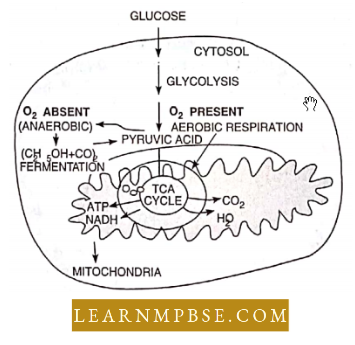
In this kind, the breakdown is complete and a lot of energy is released. On the other hand, in anaerobic respiration, as O2 is not needed, the breakdown is incomplete and less energy is released.
Aerobic And Anaerobic Respiration In Plants
- During aerobic respiration, pyruvic acid is formed from glucose in the first step. The various reactions take place in the cytoplasm. This step is called glycolysis.
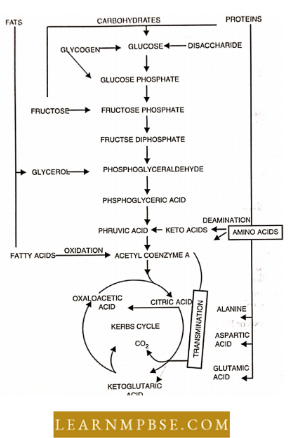
Pyruvic acid enters mitochondria and changes into Acetyl COA which then enters Krebs’ cycle in mitochondria to produce H-,0 and CO–, NADH-, and FADH, produced in Krebs’ cycle enter ETS to release ATP molecules (energy source). There”is terminal oxidation and oxidative phosphorylation.
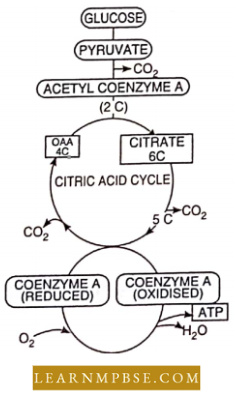
NEET Biology Respiration In Plants Glycolysis
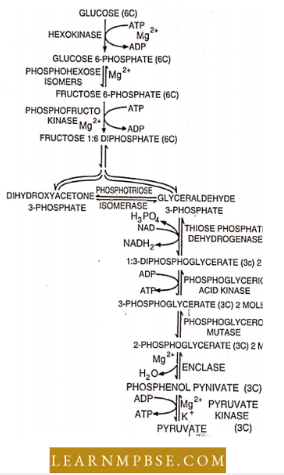
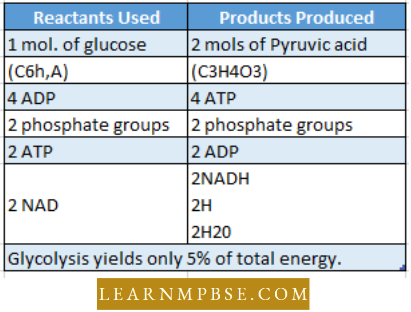
NEET Biology Respiration In Plants Other Methods Of Formation Of Pyruvic Acid
In addition to the EMP pathway, pyruvic acid
Can also be formed by following metabolic pathways of carbohydrates :
- Hexose monophosphate pathway or shunt (HMP) Pentose phosphate pathway or 6-Phosphogluconate pathway
- Phosphoketolase pathways.
- Entner-Duodoroff (ED) pathway.
- Hexose monophosphate pathway (HMP):
Pathway Definition:
This is a multifunctional process primarily designed to produce reducing power in the form of NADPH, which acts as a donor of hydrogen and electrons in several reductive biosynthetic pathways, including in the synthesis of fatty acids and steroids.
- The HMP details were provided by Warberg and Dickens, so it is referred to as the YVarberg-Dickens pathway. Event.
- It is present in various animal tissues, including the liver (phospholipid synthesis), mammary glands (milk fat synthesis), adipose tissue (fatty acid synthesis), erythrocytes, adrenal cortex, and other endocrine glands associated with steroid hormone synthesis. It is lacking in the muscle cells. It also transpires in the
Pathway Properties:
- In HMP, ATP is neither consumed nor produced.
- It occurs in the extramitochondrial cytoplasm which has all the enzymes of HMP.
- In this, hexoses arc is converted into pentoses, especially ribose-5-P.
- It is also called the direct oxidative pathway because in this C-l of glucose is oxidized first (In glycolysis, C3 and C4 are first oxidized),
- The co-enzyme used in oxidative reactions of HMP is NADP+ which is reduced to NADPII + H+ (In glycolysis, the H-acceptor used is NAD+).
- CO2 is produced.
- It provides an alternative route other than glycolysis for carbohydrate breakdown.
- It provides the erythrose-4-phosphate required for the synthesis of shikimic acid. It is the precursor of an aromatic ring compound.
- It generates NADPII molecules which are used as reductants in biosynthetic processes under conditions when NADPH molecules are not generated by photosynthesis.
- It is, therefore, important in non-photosynthetic tissues such as in differentiating tissues, germinating seeds, and during periods of darkness. Production of NADPH is not linked to ATP generation in the pentose phosphate pathway.
- It provides ribose sugar for the synthesis of nucleic acids.
- It plays an important role in the fixation of CO2.
Glycolysis And Krebs Cycle NEET
NEET Biology Respiration In Plants Oxidation Of Pyruvic Acid Formation of Acetyl Co-A
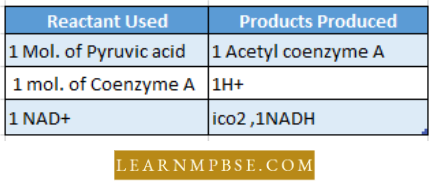
The Acetyl Co A is the connecting link between glycolysis and Krebs’ cycle.
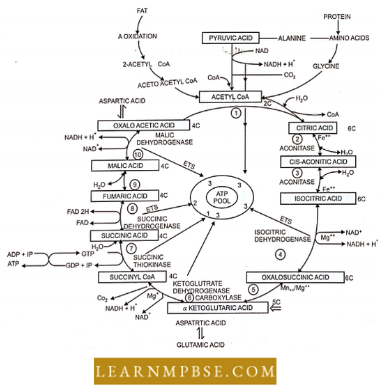
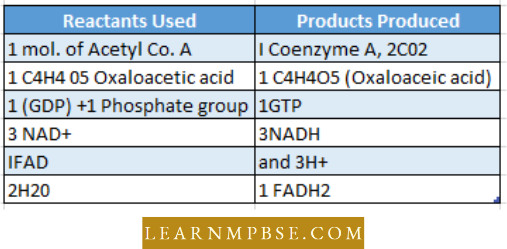
NEET Biology Respiration In Plants Electron Transport System Ets Or Cytochrome System Cs
Cytochromes identified by Mac Cunn are intrinsic proteins abundant in iron (Fe+2). Cyt a3 contains both Cu²⁺ and Fe²⁺ and functions as cytochrome oxidase.
- It is the primary energy source within a cell. It additionally regenerates coenzymes and creates water. The hydrogen atom pairs that dissociate from the prior processes do not directly combine with oxygen to produce water; instead, they first traverse a sequence of seven intermediate carriers situated on the inner mitochondrial membrane, including the cristae.
- The transfer of electrons releases energy at three stages during the enzymatic binding of ADP and inorganic phosphate to produce ATP. The mechanism of energy storage via electron transport in the phosphate bond of ATP is termed oxidative phosphorylation.
The sequence of electron carriers is :
- NADH2 → FMN -V FeS
→ CoQ → Cyt b →Cyt c
- → Cyt a-a3 oxygen.
ATP Synthesis according to Chemisoniatic hypothesis (Peter Mitchell 1979).
- It involves the passage of 2e from NADH2 pushing out three pairs of protons from the inner to the outer chamber of mitochondria resulting in proton gradient and electric potential.
- These two jointly create a proton motive force. It causes the proton to move back through proton channels of F0 particles. Energy is made available to F0 particles for the synthesis of ATP as these particles have ATP activity
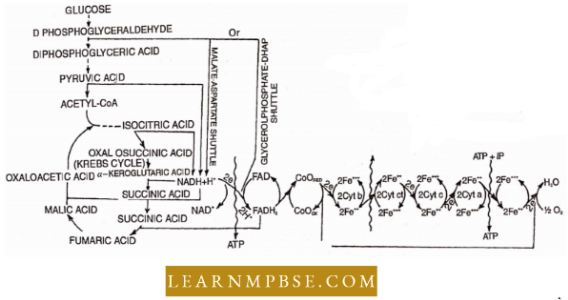
NEET Biology Respiration In Plants Factors Affecting Respiration In Plants
External Factors :
- Light. Light has no direct effect, however, the respiration rate is higher in sunlight than in darkness.
- Temperature. Respiration is maximum at 30°C. Above this temperature respiration rate decreases due to denaturation of enzymes. At low temperatures (zero or below zero) the enzymes become inactive and thus respiration decreases.
- Low temperatures in cold storage are useful in storing food grains, and vegetables. In hilly areas, the temperature is low at night and moderate during the day causing reduced respiration and high photosynthesis.
- According to Vant Hoffs law, the rate of respiration increases 2-2.5 times with every 10°C increase in temperature between 0-25°C, i.e. Q10 = 2-2.5 (cascade effect).
- Oxygen. It is essential for aerobic respiration. A high concentration of O2 inactivates the respiratory enzyme and reduces respiration. Oxygen also inhibits the fermentation of sugar by yeast cells or anaerobic respiration (Pasteur effect).
- Carbon dioxide. Respiration decreases with increases in CO2 concentration. High CO2 concentration causes stomatal closure and checks the intake of O2. Thus reduces respiration.
- Water. Water is essential for enzyme activity. Respiration will not occur in the absence of oxygen. This is the reason that dry seeds with 8-12% moisture do not germinate unless watered.
- Wound and injuries. For healing the injured areas, respiration is increased.
- Chemicals. Cyanide and carbon monoxide inhibit respiration.
Respiration In Plants NEET Notes
Internal Factors: Protoplasm. (Meristematic) cells with dense protoplasm have a high rate of respiration.
- Substrate. The rate of respiration is directly proportional to the amount of substrate. Respiration decreases if end products accumulate.
Outline of ATP production during aerobic oxidation of glucose to CO2 and H2O
GLYCOLYSIS
- ATP produced directly ….4 molecules
- ATP consumed …. 2 molecules
- Net gain of ATP … 2 molecules
- From hydrogen produced and sent down the electron transport system Route II and Route I (2 x 2) / (2 x 3) respectively 4/6 molecules
Pyruvic Acid Oxidation
- From hydrogen produced and sent down the electron transport system (2×3) 6 molecules
Krebs’ Cycle (Tricarboxylic Acid Cycle)
- ATP produced directly (From GTP) …. 2 molecules
- From hydrogen accepted by NAD (3 x 3) ….9 molecules
- Therefore for the two molecules of citric acid metabolized (9×2)….18 molecules
- From hydrogens accepted by FAD (1×2) …. 2 molecules
- Thus for the two molecules of citric acid metabolized (2 x 2) …..4 molecules
- Total ..36/38 molecules
2 molecules of ATP consumed in transferring NADH into mitochondria in eukaryotes _2 molecules
Net gain of ATP in eukaryotes = 36 molecules
NEET Biology Respiration In Plants Anaerobic Respiration
The path for anaerobic respiration from glucose to pyruvic acid is the same as in aerobic respiration i.e. glycolysis.
- Pyruvic acid then forms ethyl alcohol and CO2 or lactic acid. All these reactions occur in the cytoplasm and mitochondria are not involved.
- Fate of Pyruvic acid in anaerobic respiration. When there is no oxygen available to
accept hydrogen atom, pyruvic acid (the end product of glycolysis) itself becomes the acceptor
of hydrogen ions and protons. - In animals, when cells are temporarily deprived of oxygen (as in skeletal muscles during exercise), pyruvic acid is converted into Inctic acid.
- In this reaction, NADH produced in glycolysis is oxidized into NAD+, and the two protons and two electrons So released are used in the conversion of pyruvic acid into lactic acid.
- The accumulation of lactic acid in the muscle causes fatigue. However, during rest, the lactic acid is again converted into pyruvic acid and undergoes aerobic respiration. Many bacteria obtain energy from glycolysis and convert pyruvic acid to lactic acid.

The net yield of ATP in anaerobic respiration.
There is a gain of only 2 molecules of ATP, that too, during glycolysis in anaerobic respiration. Production of much lesser ATP moleculeÿ, during anaerobic respiration is due to the following reasons-
- Reactions do not proceed beyond glycolysis.
- Even NADH produced in glycolysis is not channeled through the respiratory chain to produce ATP. Instead, it is used in the reduction of pyruvic acid.
Respiration In Plants NEET Mcqs With Answers
Fermentation differs from anaerobic respiration by the following features-
- Fermentation is an extracellular process.
- It usually occurs in microbes.
- Enzymes extracted from cells perform fermentation.
- A small quantity of oxygen rather stimulates fermentation while anaerobic respiration occurs in the absence of oxygen.
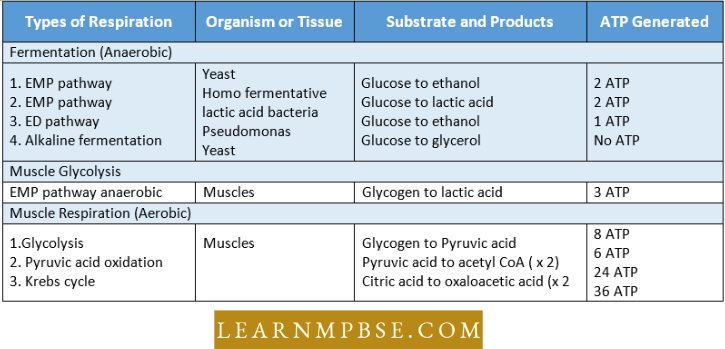
The energy stored during photosynthesis in carbohydrates In plants glucose is derived from sucrose. The latter such as glucose and starch, is released by breaking the C-C bonds of such molecules through oxidation for cellular use.
- This process of release of energy is called respiration.
- One molecule of glucose releases about 2870 KJ of energy during aerobic respiration and 247 KJ during anaerobic respiration.
- In plants, glucose is derived from sucrose. The latter is converted into glucose and fructose by an enzyme invertase and these two molecules readily enter the glycolysis pathway.
- The total energy yield from 38 molecules comes to 12c KJ (one ATP molecule yields 34 KJ of energy). Enter released in one molecule of glucose on complete oxidation corresponds to 2870 KJ. Tim the efficiency is 45 percent and the rest of the energy is lost as heat.
- In the bacterium Pseudomonas, glucose gives rise to pyru¬vic acid through the ED pathway. In this bacterium a molecule of glucose yields only one molecule of pyruvic acid. One ATP molecule is used and two are generated with a net gain of I ATP. Pyruvic acid is decarboxylated to acetaldehyde, which is then reduced to ethanol as in yeast.
- Plants show cyanide-resistant respiration because of an additional enzyme catalase which converts O2 into water and oxygen. This respiration induces climacteric effect and atherogenicity
NEET Biology Respiration In Plants Quanta To Memory
- Respiration is independent of light.
- Photosynthesis is 10 times faster than respiration.
- Efficiency of energy is 40-45%.
- The term respiration was coined by Dutrocliet.
- 264 gms of CO2 is liberated during the complete oxidation of 180 gms. of glucose.
- 88 gms of ethyl alcohol is formed by partial oxidation of 180 gms. of glucose.
- 92 gms. of CO2 is formed by anaerobic respiration of 180 gms of glucose.
- All the respiratory substrates join a common scheme of oxidation, Krebs’ cycle.
- All enzymes, substrates, intermediates, and end products of glycolysis are present in the cytosol.
- Krebs cycle is the central pathway of cell respiration where the catabolic pathways converge upon it and anabolic pathways diverge from it.
- The only high-energy phosphate produced in the Krebs cycle is GTP.
- Glucose is the most common respiratory substrate.
- During starvation, first glycogen, then, fats, and finally proteins are oxidized to liberate energy.
- Ripening fruits show an increase in the rate of respiration (climacteric respiration)
- F0 carries proton channels while F0 has ATP ase activity according to Mitchell’s chemiosmotic coupling theory.
- Each pyruvic acid produces 15 ATP molecules in aerobic respiration while each Acetyl Co-A produces
- 12 ATP molecules.
- Krebs cycle is also called the Amphibolic process in which a number of intermediates of the Krebs cycle are used in anabolic pathways.
- The ratio of ATP in aerobic and anaerobic respiration is 18.1 (36:2)
- The ratio of C09 formation in aerobic and anaerobic respiration is 3:2.
- Respiratory poisons are 2, 4 dinitrophenol, Antimycin-A, and cyanides.
- Fats constitute the reserve energy and are used only after the consumption of carbohydrates. Proteins are used only after the consumption of both carbohydrates and fats.
- Cytochromes are Fc-containing electron carriers except cytochrome which contains both Fe and Cu.
- The pentose phosphate pathway: Also called hexose Monophosphate shunt, was explained by Warburg and Dickens. As a result of PPP, overall 35 ATP molecules are produced. It occurs in the cytosol. In the liver, this pathway is responsible for nearly 60% of the total carbohydrate oxidation,
- Pasteur effect: Reduction in the amount of breakdown of the respiratory substrate and evolution of CO, when an anaerobically respiring material is brought into an O2-containing environment.
- Dormant seeds represent a state of autooxidation.
- Acetyl CoA is the common intermediate of carbohydrate and fat metabolism.
- Fermentation was discovered by Gay Lussac.
- The enzyme extracted from yeasts that brought about the fermentation is zymase.
- RBCs and muscles get energy by glycolysis.
- Fruits and seeds are stored at low temperatures to reduce the rate of respiration.
- Viruses are infective agents that do not show the rate of respiration.
- If a leaf is kept in a sugar solution, its rate of respiration increases.
- The minimum concentration of O2 for aerobic respiration extinction point is 3 – 10 %.
- Dinitrophenol inhibits ATP synthesis (uncoupler of oxidative phosphorylation) but does not stop the transfer of electrons.
- Oligomycin inhibits oxidative phosphorylation (energy transfer inhibitor).
- Antimycin A stops the transfer of electrons from Cyt B to Cyt C and Cyanide prevents the transfer of electrons from cyt a3 to oxygen.
Difference Between Photosynthesis And Respiration
NEET Biology Respiration In Plants Questions For Competitive Examinations
Question 1. The three boxes in this diagram represent the three major biosynthetic pathways in aerobic respiration. Arrows represent net reactants or products.
Arrows numbered 4, 8, and 12 can all be :
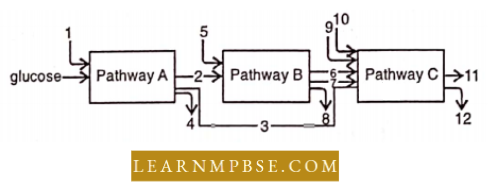
- ATP
- H20
- FAD+orFADH2
- NADH.
Answer: 4. NADH.
Question 2. Consider the following statements with respect to respiration.
- Glycolysis occurs in the cytoplasm of the cell.
- Aerobic respiration takes place within the mitochondria.
- The electron transport system is present in the outer mitochondrial membrane.
- C51H98C6 is the chemical formula of Tripalmi- tin, a fatty acid.
- Volume of O2 evolved
Respiratory quotient = Volume of O2 evolved \ Volume of CO2 consumed
Of the above statements
- 1, 2, and 4 alone are correct.
- 2, 3, and 4 alone are correct.
- 3, 4, and 5 alone are correct.
- 2, 4, and 5 alone are correct.
- 1, 3, and 5 alone are correct.
Answer: 1. 1, 2, and 4 alone are correct
Question 3. Anaerobic respiration of yeast produces :
- Oxygen
- Nitrogen
- CO2
- H2O.
Answer: 3. CO2
Question 4. Metabolism of one palmitic acid yields ATP :
- 36 ATP
- 56 ATP
- 136 ATP
- 48 ATP.
Answer: 3. 136 ATP
Question 5. Alcoholic fermentation is carried out by :
- Saccharomyces
- Lactobacillus
- Clostridium
- Aspergillus.
Answer: 1. Saccharomyces
Electron Transport Chain In Plants NEET
Question 6. Cytochrome is :
- Metallo flavoprotein
- Fe containing porphyrin pigment
- Glycoprotein
- Lipid.
Answer: 2. Fe containing porphyrin pigment
Question 7. In the case of the Kerbs cycle, the pyruvic acid before being combined with oxaloacetic acid is converted to :
- citric acid
- isocitrate
- succinyl CoA
- acetyl CoA.
Answer: 4. acetyl CoA.
Question 8. Which of the following receives electrons at the end of ETC?
- H2O
- H2
- CO2
- Cytochrome a3.
Answer: 4. Cytochrome a3.
Question 9. What is the total production of ATP at the end of a complete breakdown of one molecule of glucose during aerobic respiration?
- 4
- 8
- 38
- 34.
Answer: 3. 38
Question 10. Respiration in germinating seeds is usually high but with a decline in water and maturation the rate of respiration :
- increases steadily
- decreases steadily
- remains constant
- increases and decreases alternatively.
Answer: 2. decreases steadily
Question 11. PPP shunt is more advantageous than the Krebs cycle as :
- it utilizes less oxygen
- it reduces more of oxygen
- it yields more ATP
- ribose sugar is released which is used in the formation of nucleic acid.
Answer: 4. ribose sugar is released which is used in the formation of nucleic acid.
Question 12. The mechanism of aerobic respiration was discovered by :
- Calvin
- H. Krebs
- Hatch and
- Slack Pasteur.
Answer: 2. H. Krebs
Question 13. The dough kept overnight in a warm place becomes soft and spongy due to :
- osmosis
- absorption of CO2
- cohesion
- fermentation.
Answer: 4. fermentation.
Respiration In Plants NEET Syllabus Topics
Question 14. In glycolysis, electrons are removed by :
- ATP
- NAD
- Glyceraldehyde 3-phosphate
- Molecular oxygen.
Answer: 2. NAD
Question 15. During which stage in the complete oxidation of glucose are the greatest number of ATP molecules formed from ADP?
- Conversion of pyruvic acid to acetyl CoA
- Electron transport chain
- Glycolysis
- Krebs cycle.
Answer: 4. Krebs cycle.
Question 16. The chemiosmotic theory of ATP synthesis in the chloroplasts and mitochondria is based on :
- Proton gradient
- Membrane potential
- Accumulation of Na ions
- Accumulation of K ions.
Answer: 1. Proton gradient
Question 17. How many ATP molecules could maximally be generated from one molecule of glucose, if the complete oxidation of one mole of glucose to CO–, and H2O yields 686 kcal and the useful chemical energy available in the high energy phosphate bond of one mole of ATP is 12 kcal?
- Fifty-seven
- One
- Two
- Thirty.
Answer: 1. Fifty-seven
Question 18. Which of the following statements is/are not true?
A. one ATP molecule yields 32 kJ of energy
B. pentose phosphate pathway was discovered by Dickens
C. when tripalmitin is used as a substrate, the R.Q. is 0.7
D. energy released by one molecule of glucose on complete oxidation corresponds to 1292 kJ.
- A, B, and D
- only C and D only
- A and D only
- A, C, and D only.
- C only.
Answer: 3. A, C, and D only.
Question 19. All enzymes of the TCA cycle are located in the mitochondrial matrix except one which is located in inner mitochondrial membranes in eukaryotes and the cytosol in prokaryotes. This enzyme is :
- isocitrate dehydrogenase
- malate dehydrogenase
- succinate dehydrogenase
- lactate dehydrogenase.
Answer: 3. succinate dehydrogenase
Question 20. The overall goal of glycolysis. Krebs cycle and the electron transport system is the formation of:
- ATP in one large oxidation reaction
- Sugars
- Nucleic acids
- ATP in small stepwise units.
Answer: 4. ATP in small stepwise units.
Electron Transport Chain In Plants NEET
Question 21. Which one of the following mammalian cells is not capable of metabolizing glucose to carbon dioxide aerobically?
- Unstriated muscle cells
- Liver cells
- Red blood cells
- White blood cells.
Answer: 3. Red blood cells
Question 22. Which of the metabolites is common to the respiration-mediated breakdown of fats, carbohydrates, and proteins?
- Frutosc 1,6- bisphosphate
- Pyruvic acid
- Acetyl CoA
- Glucose – 6 – phosphate
Answer: 3. Acetyl CoA
